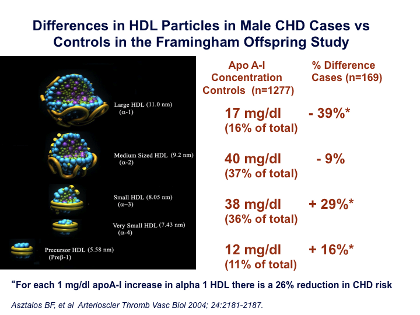Schaefer - Figure 9 - HDL particles cases vs controls Text
The gel electrophoresis techniques shown above in the fourth Figure can be used to diagnose inborn errors of HDL metabolism; however, these are quite rare. In the real world, patients with CHD can usually be diagnosed based on changes in their spectrum of HDL particle sizes. This Figure summarizes the differences in the HDL particle spectrum between healthy subjects and men with CHD, from the Framingham Offspring Study.[28] As can be seen, patients with CHD tend to have significant reductions in the large HDL particles (in this study there was a 40% reduction in the very large particles, concomitant with increases in the smaller particles). This concurs with the understanding of HDL metabolism, using stable isotopes, that the HDL cascade begins with the small, pre-beta and alpha4 lipoprotein particles, and then as the HDL particles circulate they accumulate free cholesterol, becoming larger and larger, until the alpha1 HDL particles discharge their cholesterol to the liver (or, via CETP, back to VLDL/LDL particles) and then the apoA-I recycles and the process recommences.
Many years ago in Time magazine these HDL particles were described as dump trucks that pick up cholesterol and transport it to the liver, where they dump it. This is actually a rather accurate description – the small HDL particles are the “empty” dump trucks, and it is the large, “full” dump trucks that unload the cholesterol to the liver for excretion or, via CETP, back to VLDL/LDL particles for recirculation. In this way the HDL lipoprotein gets reutilized and goes around this metabolic system about 8 times, as far as we can tell.
J Clin Lipidol. 2011; 5(6).References
[28]Asztalos BF, Adrienne Cupples L, Demissie S, et al. Prevalence in Male Participants of the Framingham Offspring Study High-Density Lipoprotein Subpopulation Profile and Coronary Heart Disease. Arterioscler Thromb Vasc Biol. 2004;24:2181-2187.
